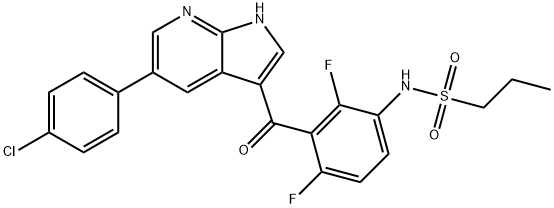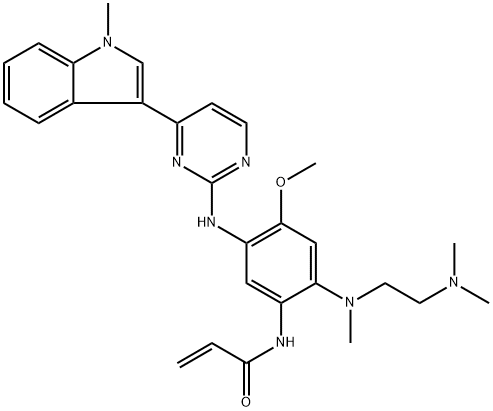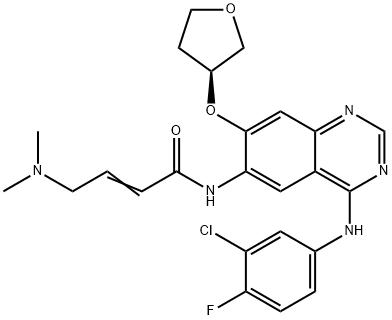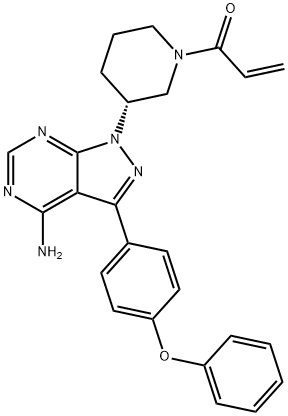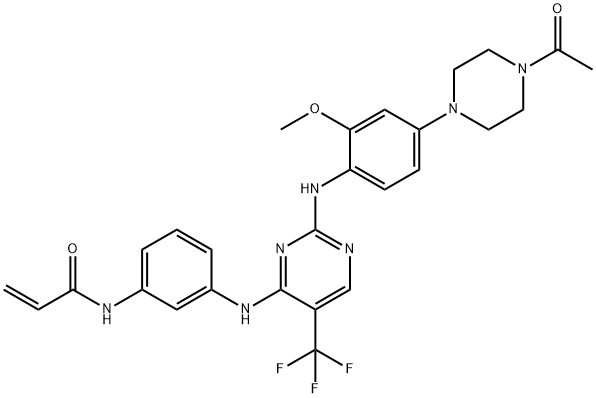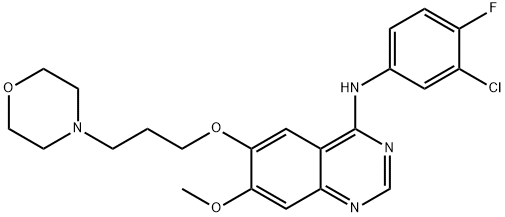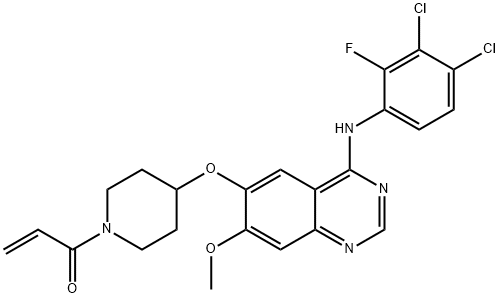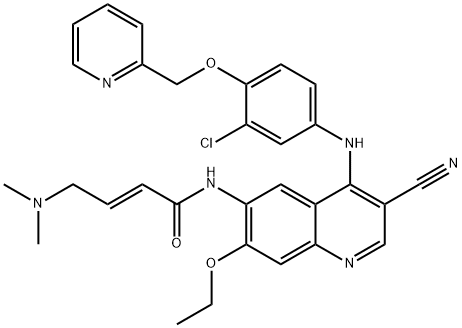Dacomitinib (PF299804)
Synonym(s):(2E)-N-[4-[(3-chloro-4-fluorophenyl)amino]-7-methoxy-6-quinazolinyl]-4-(1-piperidinyl)-2-butenamide;PF-00299804;PF-00299804-03;PF-299
- CAS NO.:1110813-31-4
- Empirical Formula: C24H25ClFN5O2
- Molecular Weight: 469.94
- MDL number: MFCD19443734
- EINECS: 000-000-0
- SAFETY DATA SHEET (SDS)
- Update Date: 2025-12-23 21:30:31

What is Dacomitinib (PF299804)?
Absorption
Dacomitinib has shown a linear kinetics after single and multiple dose range studies. The absorption and distribution do not seem to be affected by food or the consumption of antacids. The peak plasma concentration after a dosage of 45 mg for 4 days is of 104 ng/ml. The reported AUC0-24h and tmax are of 2213 ng.h/mL and 6 hours, respectively. As well, following oral administration, the absolute oral bioavailability is 80% .
Toxicity
The maximum asymptomatic dose in rats was 50 mg/kg . In animal studies, dacomitinib was shown to induce embryo-fetal toxicity, as demonstrated by an increased incidence of a post-implantation loss and reduced fetal body weight at doses resulting in exposures near the exposure at the 45mg human dose following administration in rats during the period of organogenesis. On the other hand, dacomitinib was showed to lack a mutagenic potential in a bacterial reverse mutation assay, in human lymphocyte chromosome aberration assay and in clastogenic or aneugenic in vivo rat bone marrow micronucleus assay.
The dose-limiting and overdose toxicities include stomatitis, rash, palmar-plantar erythrodysesthesia syndrome, dehydration, paronychia, and diarrhea. From these findings, the maximum tolerated dose (defined by the dose in which the dose-limiting toxicities did not exceed 33%) is 45 mg.
Description
The epidermal growth factor receptors (EGFR), whose members include ErbB1 (HER1), ErbB2 (HER2), ErbB3 (HER3), and ErbB4 (HER4), are receptor tyrosine kinases that are often over-
The Uses of Dacomitinib (PF299804)
PF299804 is a potent, irreversible pan-ErbB inhibitor against ErbB1, ErbB2 and ErbB4 with IC50 of 6 nM, 45.7 nM and 73.7 nM, respectively.
The Uses of Dacomitinib (PF299804)
Dacomitinib is an Erb-inhibitor, or an inhibitor of the members of the epidermal growth factor receptor family. Used as an ant-cancer agent due to observation of over-expressed epidermal growth factor receptor in nearly all cases of squamous cell carcinoma in the head and neck.
Indications
Dacomitinib is indicated as the first-line treatment of patients with metastatic non-small cell lung cancer (NSCLC) with epidermal growth factor receptor (EGFR) exon 19 deletion or exon 21 L858R substitution mutations as verified by an FDA-approved test.
Lung cancer is the leading cause of cancer death and NSCLC accounts for 85% of lung cancer cases. From the cases of NSCLC, approximately 75% of the patients present a late diagnosis with metastatic and advanced disease which produces a survival rate of 5%. The presence of a mutation in EGFR accounts for more than the 60% of the NSCLC cases and the overexpression of EGFR is associated with frequent lymph node metastasis and poor chemosensitivity.
Background
Dacomitinib, designed as (2E)-N-16-4-(piperidin-1-yl) but-2-enamide, is an oral highly selective quinazalone part of the second-generation tyrosine kinase inhibitors which are characterized by the irreversible binding at the ATP domain of the epidermal growth factor receptor family kinase domains.
Dacomitinib was developed by Pfizer Inc and approved by the FDA on September 27, 2018. Some evidence in the literature suggests the therapeutic potential of dacomitinib in the epithelial ovarian cancer model, although further investigations are needed.
Definition
ChEBI: A member of the class of quinazolines that is 7-methoxyquinazoline-4,6-diamine in which the amino group at position 4 is substituted by a 3-chloro-4-fluorophenyl group and the amino group at position 6 is substituted by an (E)-4-(piperidin 1-yl)but-2-enoyl group.
brand name
VizimproTM
General Description
Class: receptor tyrosine kinase
Treatment: NSCLC with EGFR alterations
Oral bioavailability = 80%
Elimination half-life = 70 h
Protein binding = 98%
Pharmacokinetics
Preclinical data suggested that dacomitinib increases the inhibition of the epidermal growth factor receptor kinase domain as well as the activity in cell lines harboring resistance mutations such as T790M. This activity further produced a significant reduction of EGFR phosphorylation and cell viability. In these studies, non-small cell lymphoma cancer cell lines with L858R/T790M mutations where used and an IC50 of about 280 nmol/L was observed.
In clinical trials with patients with advanced non-small cell lung carcinoma who progressed after chemotherapy, there was an objective response rate of 5% with a progression-free survival of 2.8 months and an overall survival of 9.5 months. As well, phase I/II studies showed positive dacomitinib activity despite prior failure with tyrosine kinase inhibitors.
Phase III clinical trials (ARCHER 1050), done in patients suffering from advanced or metastatic non-small cell lung carcinoma with EGFR-activating mutations, reported a significant improvement in progression-free survival when compared with gefitinib.
in vitro
dacomitinib reduced the phosphorylation of her2, egfr, her4, akt, anderkin the majority of sensitive lines. dacomitinib exerted its antiproliferative effect through a combined g0–g1 arrest and an induction of apoptosis. dacomitinib inhibited growth in several her2-amplified lines with de novo and acquired resistance to trastuzumab. dacomitinib maintained a high activity in lines with acquired resistance to lapatinib. this study identifies her2-amplified breast cancer lines as most sensitive to the antiproliferative effect of dacomitinib and provides a strong rationale for its clinical testing in her2-amplified breast cancers resistant to trastuzumab and lapatinib [1].
in vivo
to evaluate the in vivo efficacy of pf00299804, the authors generated xenografts in nu/nu mice using hcc827 gfp and hcc827 del/t790m cells and treated the mice with pf00299804. pf00299804 effectively inhibited the growth of hcc827 gfp xenografts. pf00299804 treatment was substantially more effective at inhibiting growth of this xenograft model than gefinitib. thus, these preclinical models suggest that pf00299804 may be quite effective against lung cancers that become resistant to gefitinib or erlotinib via acquisition of a t790m mutation in egfr [2].
Metabolism
Dacomitinib presents an oxidative and conjugative metabolism marked mainly by the activity of glutathione and cytochrome P450 enzymes. After metabolism, its major circulating metabolite is an O-desmethyl dacomitinib form named PF-05199265. This metabolite has been shown to be formed by an oxidative step by CYP2D6 and to a smaller extent by CYP2C9. The following steps of the metabolism are mainly mediated by CYP3A4 for the formation of smaller metabolites.
From these metabolic studies, it was shown that dacomitinib inhibited strongly the activities of CYP2D6.
Storage
Store at +4°C
References
[1] kalous o, conklin d, desai aj, o'brien na, ginther c, anderson l, cohen dj, britten cd, taylor i, christensen jg, slamon dj, finn rs. dacomitinib (pf-00299804), an irreversible pan-her inhibitor, inhibits proliferation of her2-amplified breast cancer cell lines resistant to trastuzumab and lapatinib. mol cancer ther. 2012;11(9):1978-87.
[2] engelman ja, zejnullahu k, gale cm, lifshits e, gonzales aj, shimamura t, zhao f, vincent pw, naumov gn, bradner je, althaus iw, gandhi l, shapiro gi, nelson jm, heymach jv, meyerson m, wong kk, jfinne pa. pf00299804, an irreversible pan-erbb inhibitor, is effective in lung cancer models with egfr and erbb2 mutations that are resistant to gefitinib. cancer res. 2007;67(24):11924-32.
Properties of Dacomitinib (PF299804)
| Melting point: | 184-187°C |
| Boiling point: | 665.7±55.0 °C(Predicted) |
| Density | 1.344 |
| storage temp. | Refrigerator |
| solubility | DMSO (Slightly), Methanol (Slightly, Heated) |
| form | White solid. |
| pka | 12.05±0.43(Predicted) |
| color | White to Pale Yellow |
| CAS DataBase Reference | 1110813-31-4 |
Safety information for Dacomitinib (PF299804)
| Signal word | Warning |
| Pictogram(s) |
 Exclamation Mark Irritant GHS07 |
| GHS Hazard Statements |
H302:Acute toxicity,oral |
| Precautionary Statement Codes |
P280:Wear protective gloves/protective clothing/eye protection/face protection. P305+P351+P338:IF IN EYES: Rinse cautiously with water for several minutes. Remove contact lenses, if present and easy to do. Continuerinsing. |
Computed Descriptors for Dacomitinib (PF299804)
New Products
Indole Methyl Resin tert-butyl 9-methoxy-3-azaspiro[5.5]undecane-3-carboxylate Boc-His(Boc)-OH 2-CTC Resin 4-Chloro-7-tosy1-7Hpyrrolo[2,3-d]pyrimidine 5,7-Dibromo-1H-indole 2,5-dichloro-N-hydroxy-4,6-dimethylpyridine-3-carboximidamide 2,2-Dimethoxy-7-azaspiro[3.5]nonane hydrochloride 4-chloromethyl-5-methyl-1,3-dioxol-2-one (DMDO-Cl) R-2-BENZYLOXY PROPIONIC ACID 1,1’-CARBONYLDIIMIDAZOLE 1,1’-CARBONYLDI (1,2-4 TRIAZOLE) N-METHYL INDAZOLE-3-CARBOXYLIC ACID 4-((2-hydroxyethyl)thio)benzoic acid 1-(TERT-BUTOXYCARBONYL)-2-PYRROLIDINONE Methyl 6-methylnicotinate 3-Pyridineacrylic acid tert-Butyl carbazate TETRAHYDRO-2H-PYRAN-3-OL 2-((4-morpholinophenylamino) (methylthio) methylene) malononitrile 3-(4-morpholinophenylamino)-5-amino-1H-pyrazole-4-carbonitrile 2,4-dihydroxybenzaldehyde 1,3-Diethyl-1,3-Diphenylurea Methyl 2-methylquinoline-6-carboxylateRelated products of tetrahydrofuran
You may like
-
 Dacomitinib 99%View Details
Dacomitinib 99%View Details -
 DACOMITINIB 1110813-31-4 95-99%View Details
DACOMITINIB 1110813-31-4 95-99%View Details
1110813-31-4 -
 Pyridine 99.5% HPLC /UV SpectroscopyView Details
Pyridine 99.5% HPLC /UV SpectroscopyView Details
110-86-1 -
 Piperazine Spot supply, best priceView Details
Piperazine Spot supply, best priceView Details
110-85-0 -
 Dibutyl PhthalateView Details
Dibutyl PhthalateView Details
84-74-2 -
 Imidazole Spot supply, competitive priceView Details
Imidazole Spot supply, competitive priceView Details
288-32-4 -
 Octadecyl 3-(3,5-di-tert-butyl-4-hydroxyphenyl)propionate 98% (GC)View Details
Octadecyl 3-(3,5-di-tert-butyl-4-hydroxyphenyl)propionate 98% (GC)View Details
2082-79-3 -
 Thiourea 99% ARView Details
Thiourea 99% ARView Details
62-56-6

